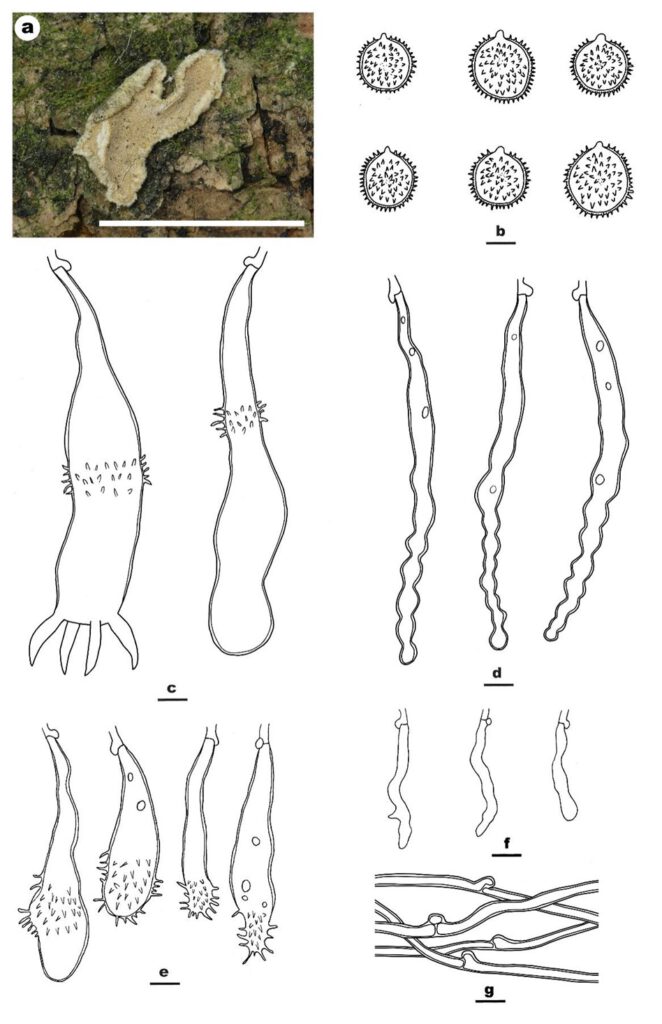Aleurodiscus globispora S.H. He & Y.F. Cao, sp. nov.
MycoBank number: MB; Index Fungorum number: IF; Facesoffungi number: FoF 10784;
Description
Sexual state:Fruiting body – Basidiomata annual, resupinate, cupulate to effuse-reflexed with slightly elevated margin, adnate, easily separated from substrate, coriaceous, small, up to 2 cm long, 1 cm wide, 400–500 µm thick. Hymenophore smooth, pruinose, light orange [5A(3–4)] to greyish orange [5B(3–6)], turning reddish-brown in KOH, uncracked; margin slightly elevated and curved toward hymenophore after dry, thinning out, slightly fimbriate, paler or concolorous with hymenophore. Context greyish white, up to 0.4 mm thick.
Microscopic structures – Hyphal system monomitic; all hyphae with clamps. Subiculum indistinct; hyphae colorless, thick-walled, smooth, loosely interwoven, rarely branched, moderately septate, 2–4 µm in diam. Subhymenium distinct, thickening; hyphae colorless, slightly thick-walled, smooth, moderately branched and septate, interwoven, more or less vertically arranged, 3–4 µm in diam. Gloeocystida moniliform, with several contractions at the apex part, colorless, slightly thick-walled, smooth, with a basal clamp connection, some with internal contents, SA–, embedded, 65–140× 8–10 µm. Acanthocystidia numerous, variable in shape and size, mostly clavate, with many spines at the apex part, colorless, slightly thick-walled, with a basal clamp connection, embedded, 50–85 × 5–25 µm. Hyphidia numerous, colorless, thin-walled, smooth, rarely branched. Basidia clavate, with many spines in the middle part, colorless, slightly thick-walled, with four sterigmata up to 25 µm long, with a basal clamp connection, 80–120 × 20–28 µm; basidioles numerous, in shape similar to basidia, but slightly smaller. Basidiospores subglobose to globose, with a prominent apiculus, colorless, with walls up to 1 µm thick, distinctly echinulate, strongly amyloid, acyanophilous, 18–24 × 17.5–22 μm, L = 20.4 μm,W = 19.7 μm,Q = 1.04 (n = 30/1).
Asexual state: not observed.
Material examined: CHINA, Guizhou Province, Yinjiang County, Fanjingshan Nature Reserve, on dead branch of Taxus chinensis (Pilger) Rehd., 12 July 2018, He 5605 (BJFC 026667, holotype).
Distribution: China
Sequence data: ITS: MW533084 (ITS5/ITS4); LSU: MW528920 (LROR/LR7)
Notes: Aleurodiscus globispora is characterized by the cupulate basidiomata, clamped generative hyphae, moniliform gloeocystidia, acanthocystidia and large, globose and echinulate basidiospores. In the phylogenetic tree, A. globispora nested within the Aleurodiscus s.s. lineage, and is closely related to A. pinicola Sheng H. Wu and A. penicillatus Burt. Aleurodiscus pinicola is similar to A. globispora in many aspects but differs in having simple-septate hyphae and slightly larger basidiospores (22.5–27.5 × 19–24 μm, Wu et al. 2019). Aleurodiscus penicillatus differs from A. globispora by having less distinct and shorter moniliform gloeocystidia (50–75 µm long) and smaller basidiospores (15–20× 13–17 µm, Núñez and Ryvarden 1997).

Fig. 3. Aleurodiscus globisporus (BJFC 026667, holotype). a Basidiomata. b Basidiospores. c Basidia. d Acutocystidia. e Acanthocystidia. f Pseudocystidia. g Hyphae from subiculum. Scale bars: a = 1 cm, b–g = 10 µm.
